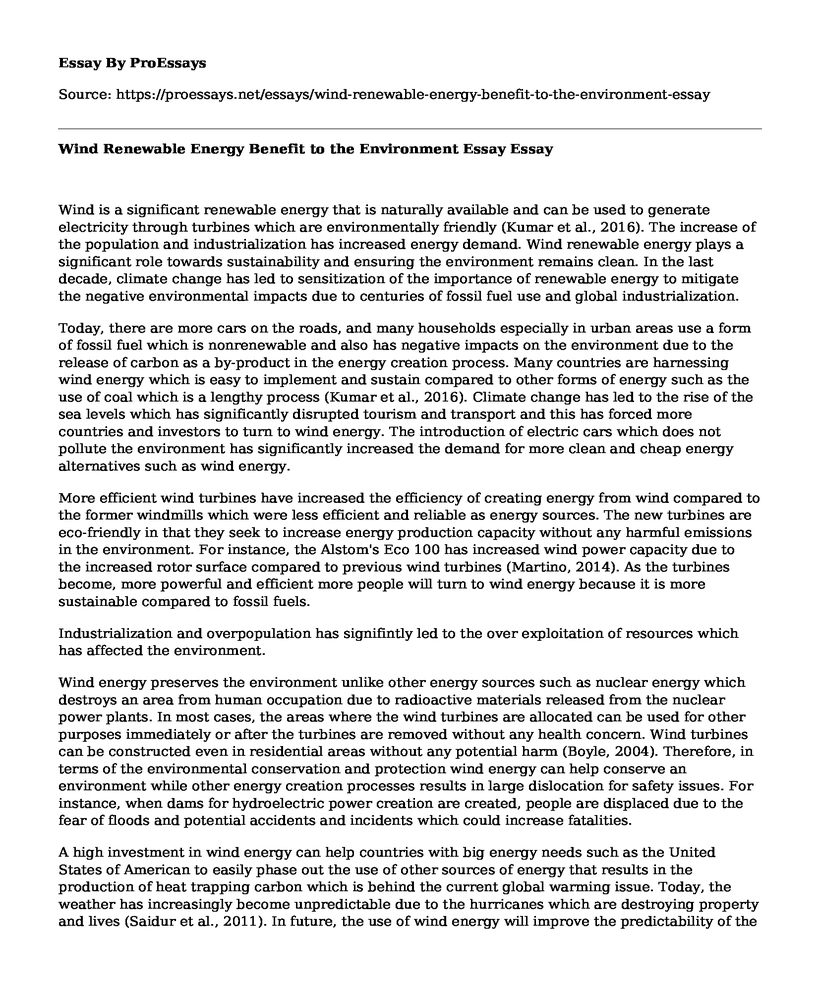Wind is a significant renewable energy that is naturally available and can be used to generate electricity through turbines which are environmentally friendly (Kumar et al., 2016). The increase of the population and industrialization has increased energy demand. Wind renewable energy plays a significant role towards sustainability and ensuring the environment remains clean. In the last decade, climate change has led to sensitization of the importance of renewable energy to mitigate the negative environmental impacts due to centuries of fossil fuel use and global industrialization.
Today, there are more cars on the roads, and many households especially in urban areas use a form of fossil fuel which is nonrenewable and also has negative impacts on the environment due to the release of carbon as a by-product in the energy creation process. Many countries are harnessing wind energy which is easy to implement and sustain compared to other forms of energy such as the use of coal which is a lengthy process (Kumar et al., 2016). Climate change has led to the rise of the sea levels which has significantly disrupted tourism and transport and this has forced more countries and investors to turn to wind energy. The introduction of electric cars which does not pollute the environment has significantly increased the demand for more clean and cheap energy alternatives such as wind energy.
More efficient wind turbines have increased the efficiency of creating energy from wind compared to the former windmills which were less efficient and reliable as energy sources. The new turbines are eco-friendly in that they seek to increase energy production capacity without any harmful emissions in the environment. For instance, the Alstom's Eco 100 has increased wind power capacity due to the increased rotor surface compared to previous wind turbines (Martino, 2014). As the turbines become, more powerful and efficient more people will turn to wind energy because it is more sustainable compared to fossil fuels.
Industrialization and overpopulation has signifintly led to the over exploitation of resources which has affected the environment.
Wind energy preserves the environment unlike other energy sources such as nuclear energy which destroys an area from human occupation due to radioactive materials released from the nuclear power plants. In most cases, the areas where the wind turbines are allocated can be used for other purposes immediately or after the turbines are removed without any health concern. Wind turbines can be constructed even in residential areas without any potential harm (Boyle, 2004). Therefore, in terms of the environmental conservation and protection wind energy can help conserve an environment while other energy creation processes results in large dislocation for safety issues. For instance, when dams for hydroelectric power creation are created, people are displaced due to the fear of floods and potential accidents and incidents which could increase fatalities.
A high investment in wind energy can help countries with big energy needs such as the United States of American to easily phase out the use of other sources of energy that results in the production of heat trapping carbon which is behind the current global warming issue. Today, the weather has increasingly become unpredictable due to the hurricanes which are destroying property and lives (Saidur et al., 2011). In future, the use of wind energy will improve the predictability of the weather and reduce the current scenario which is mainly caused by production of heat trapping carbon during the use of fossil fuels.
References
Boyle, G. (2004). Renewable energy. Renewable Energy, by Edited by Godfrey Boyle, pp. 456. Oxford University Press, May 2004. ISBN-10: 0199261784. ISBN-13: 9780199261789, 456.
Kumar, Y., Ringenberg, J., Depuru, S. S., Devabhaktuni, V. K., Lee, J. W., Nikolaidis, E., ... & Afjeh, A. (2016). Wind energy: Trends and enabling technologies. Renewable and Sustainable Energy Reviews, 53, 209-224.
Martino, J. (2014, March 14). Power Engineering. Retrieved from https://www.power-eng.com/articles/print/volume-118/issue-3/features/advancements-in-wind-turbine-technology-improving-efficiency-and-reducing-cost.html
Saidur, R., Rahim, N. A., Islam, M. R., & Solangi, K. H. (2011). Environmental impact of wind energy. Renewable and sustainable energy reviews, 15(5), 2423-2430.
Cite this page
Wind Renewable Energy Benefit to the Environment Essay. (2022, Sep 22). Retrieved from https://proessays.net/essays/wind-renewable-energy-benefit-to-the-environment-essay
If you are the original author of this essay and no longer wish to have it published on the ProEssays website, please click below to request its removal:
- Paper Example on Effects of Children's Use of Electronics before Bedtime
- Pollution Control Technologies Essay
- Paper Example on Understanding Diffusion of Innovation Theory & Its Benefits
- Offshore Drilling in Louisiana Gulf: Potential Negative Impacts - Research Paper
- Essay Example on Drones: Unmanned Aerial Vehicles for Recording & Surveillance
- Nuclear Energy: A Viable Solution for UAE's Electricity Needs - Essay Sample
- Essay Sample on Iceland: A Model of Sustainable Energy Progress







